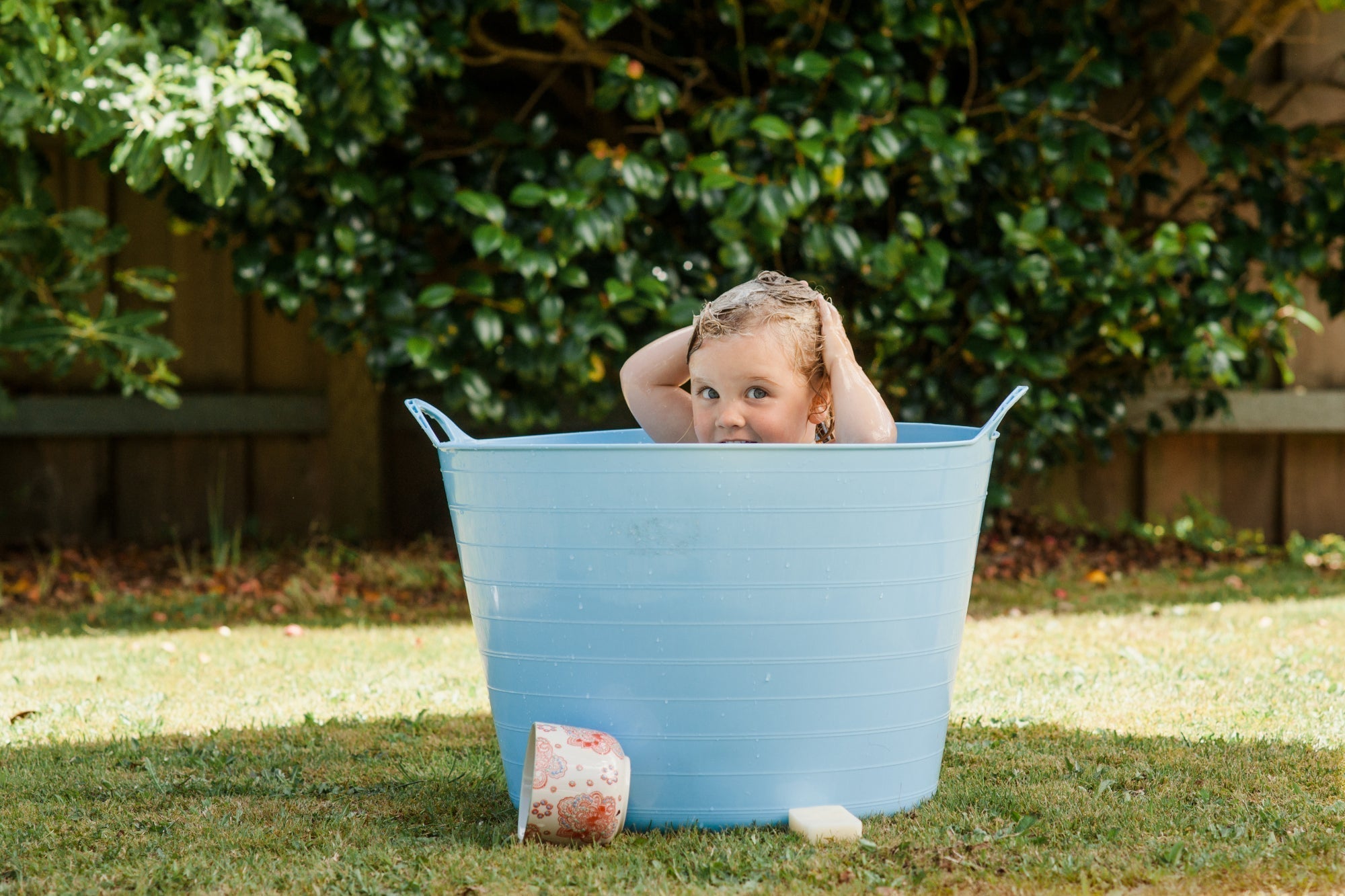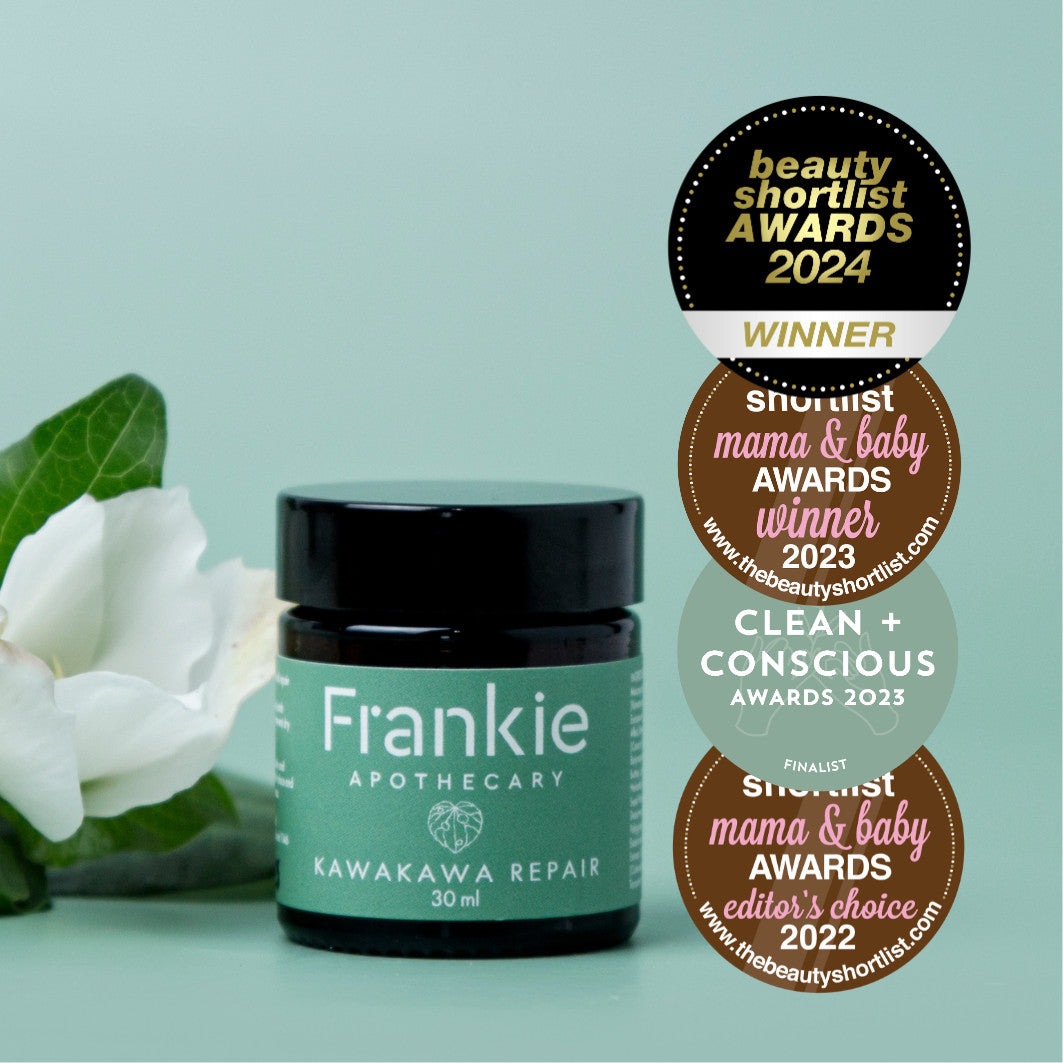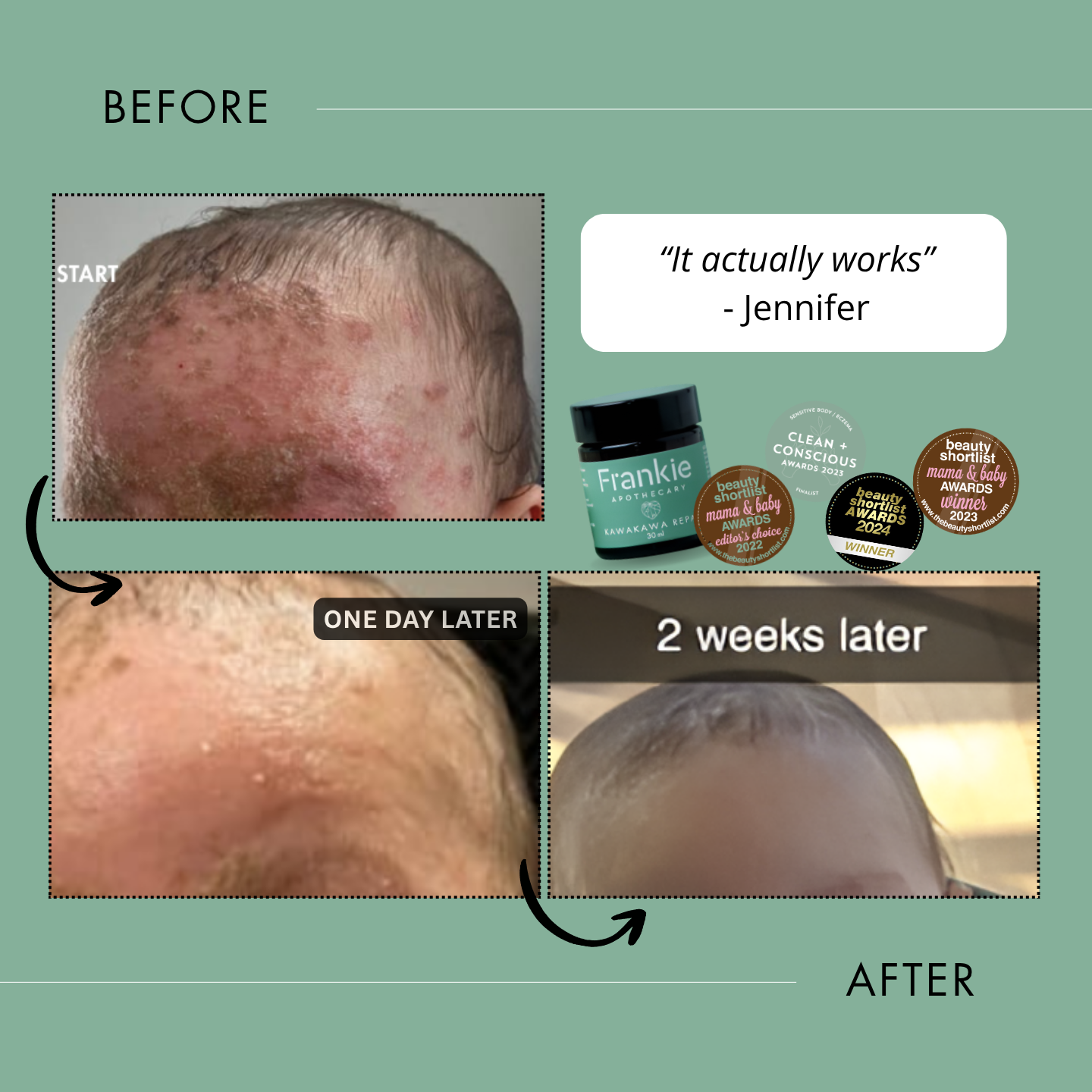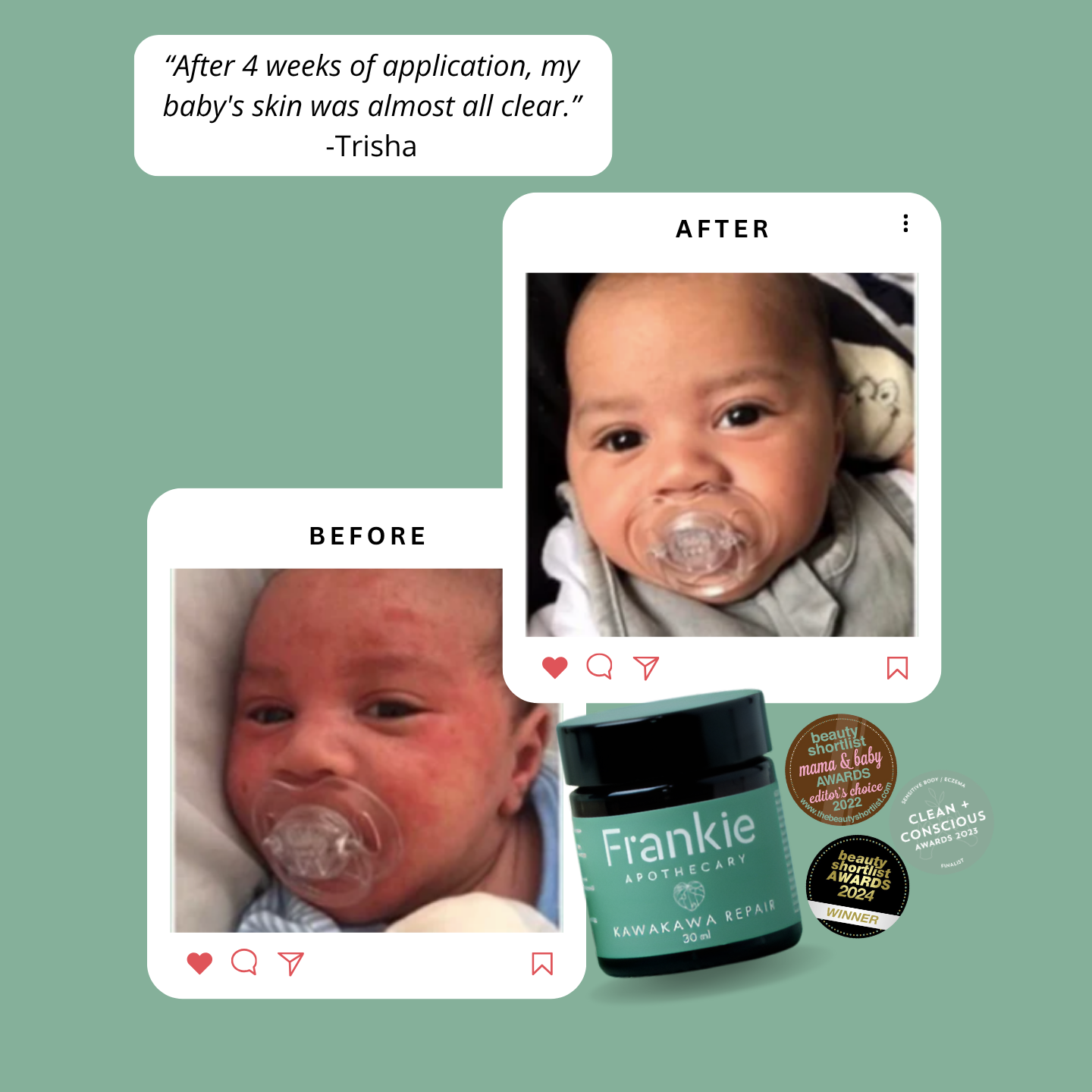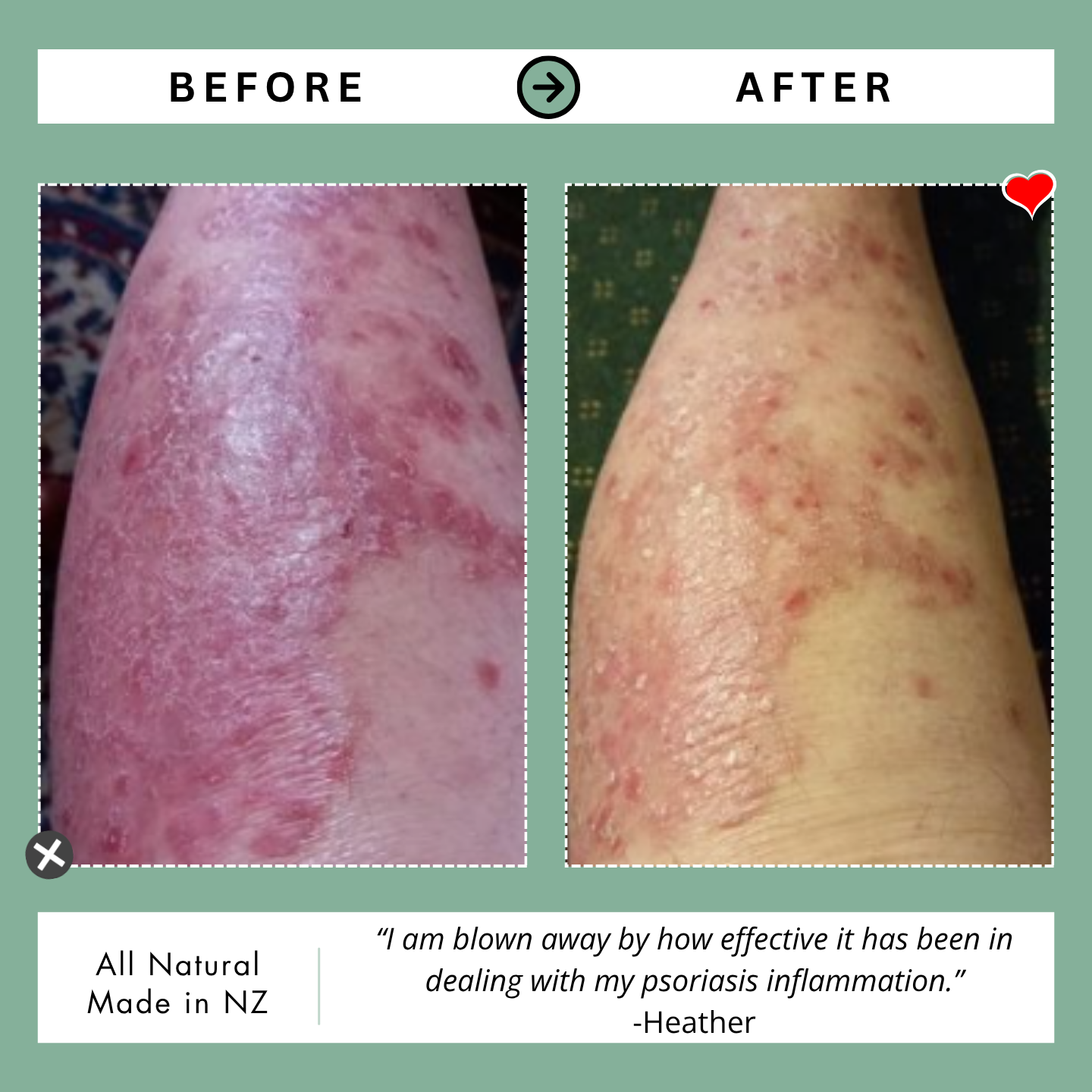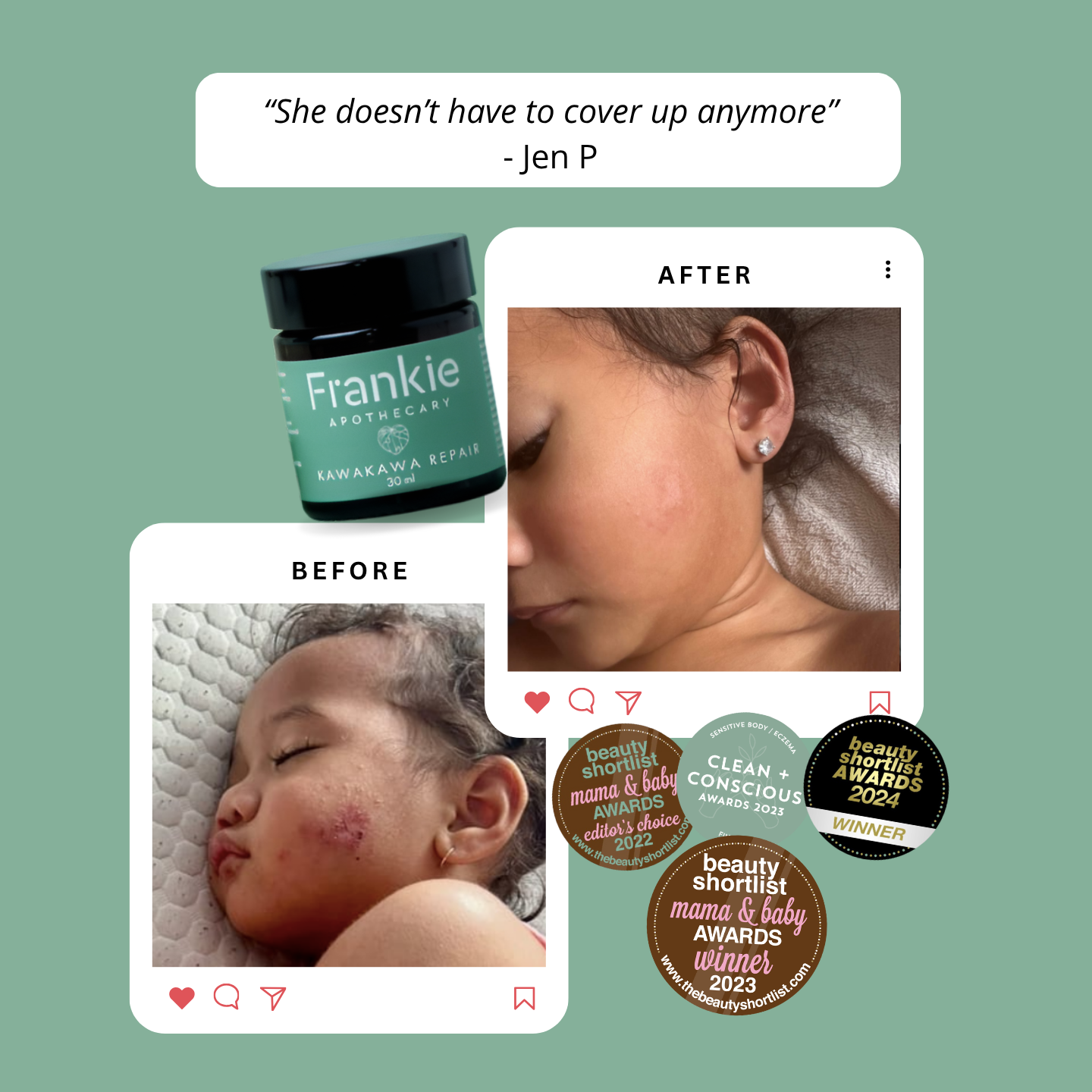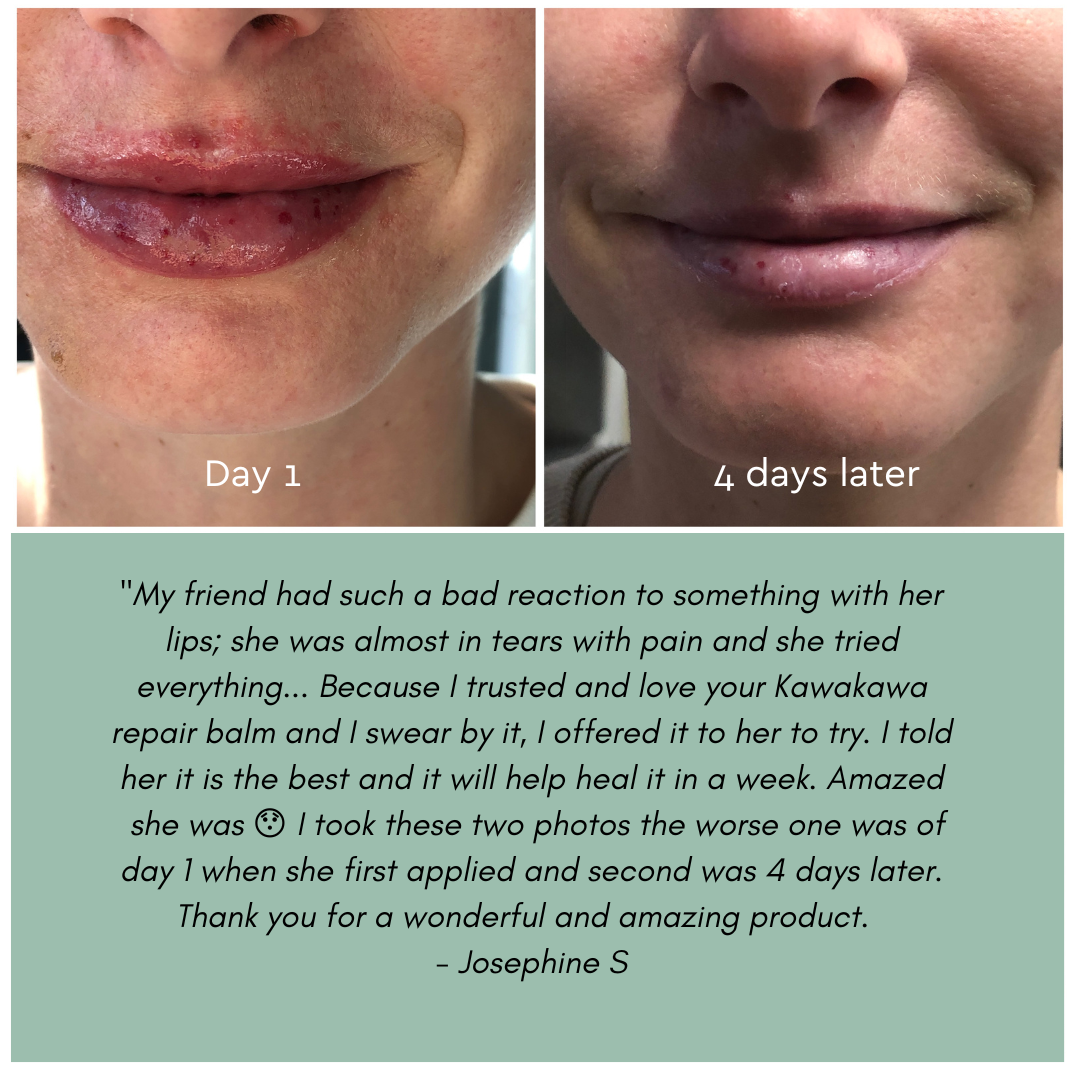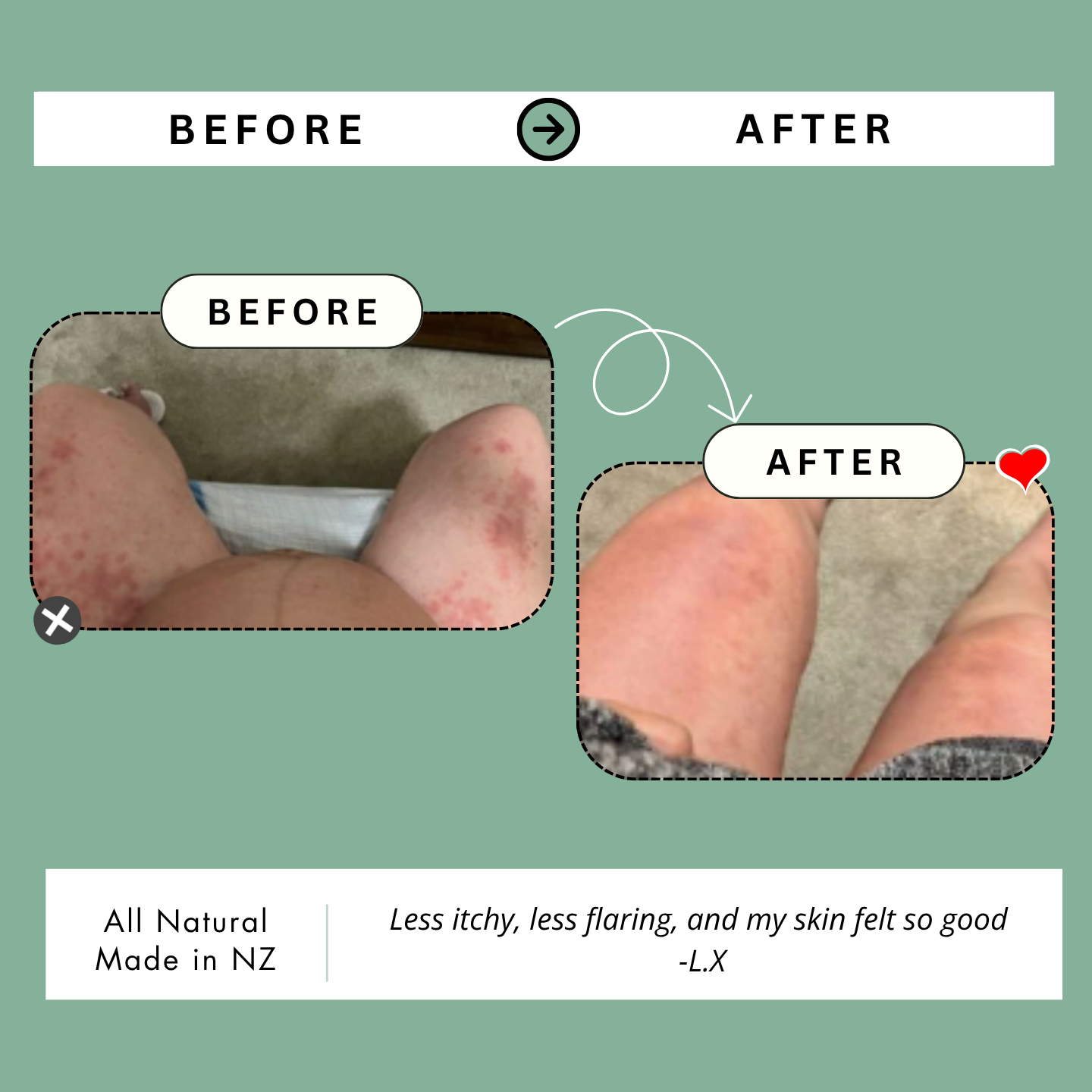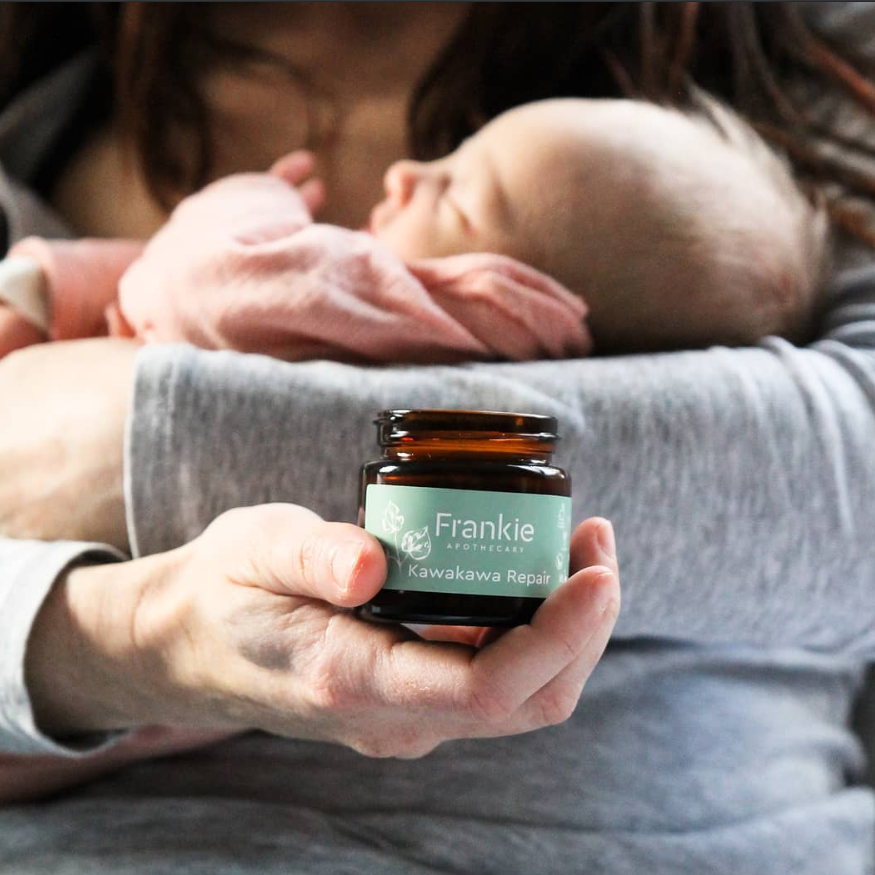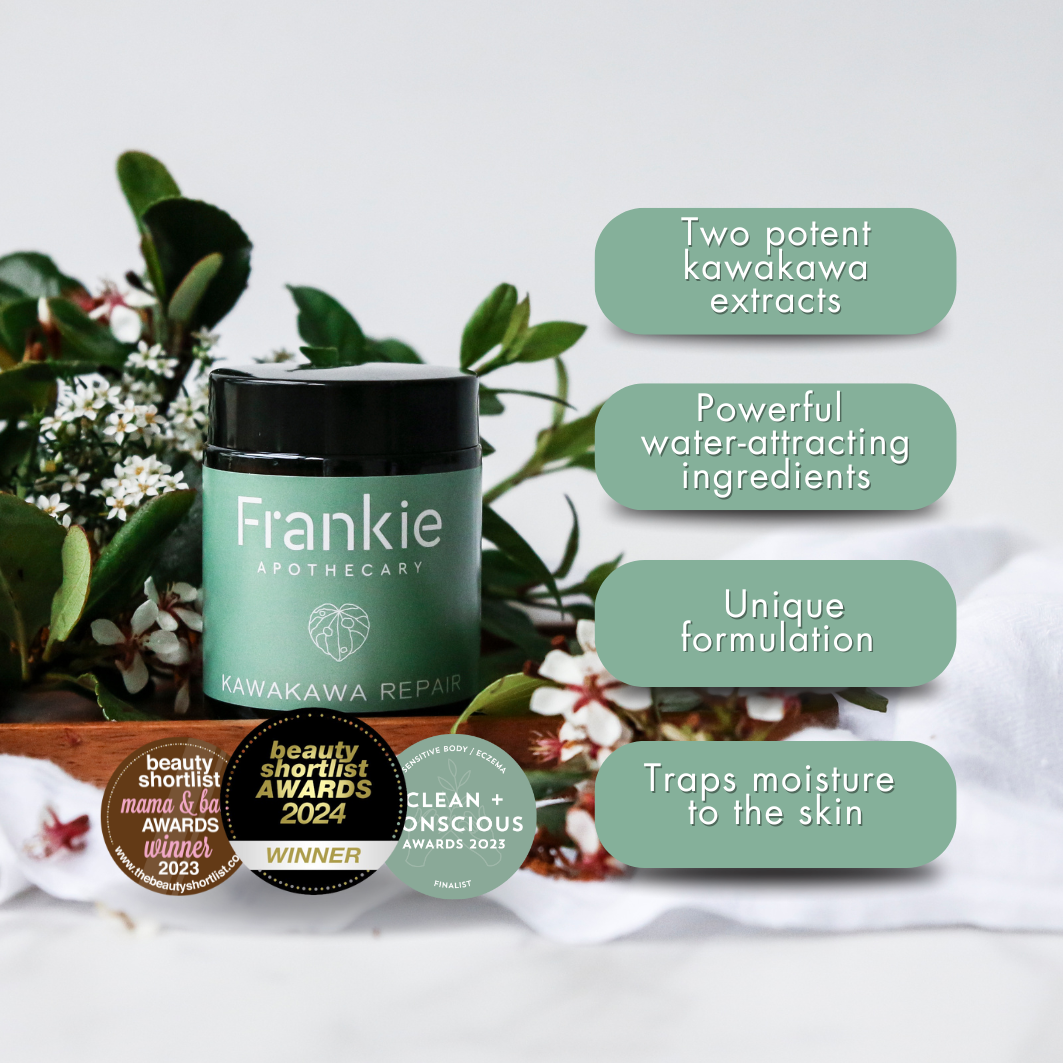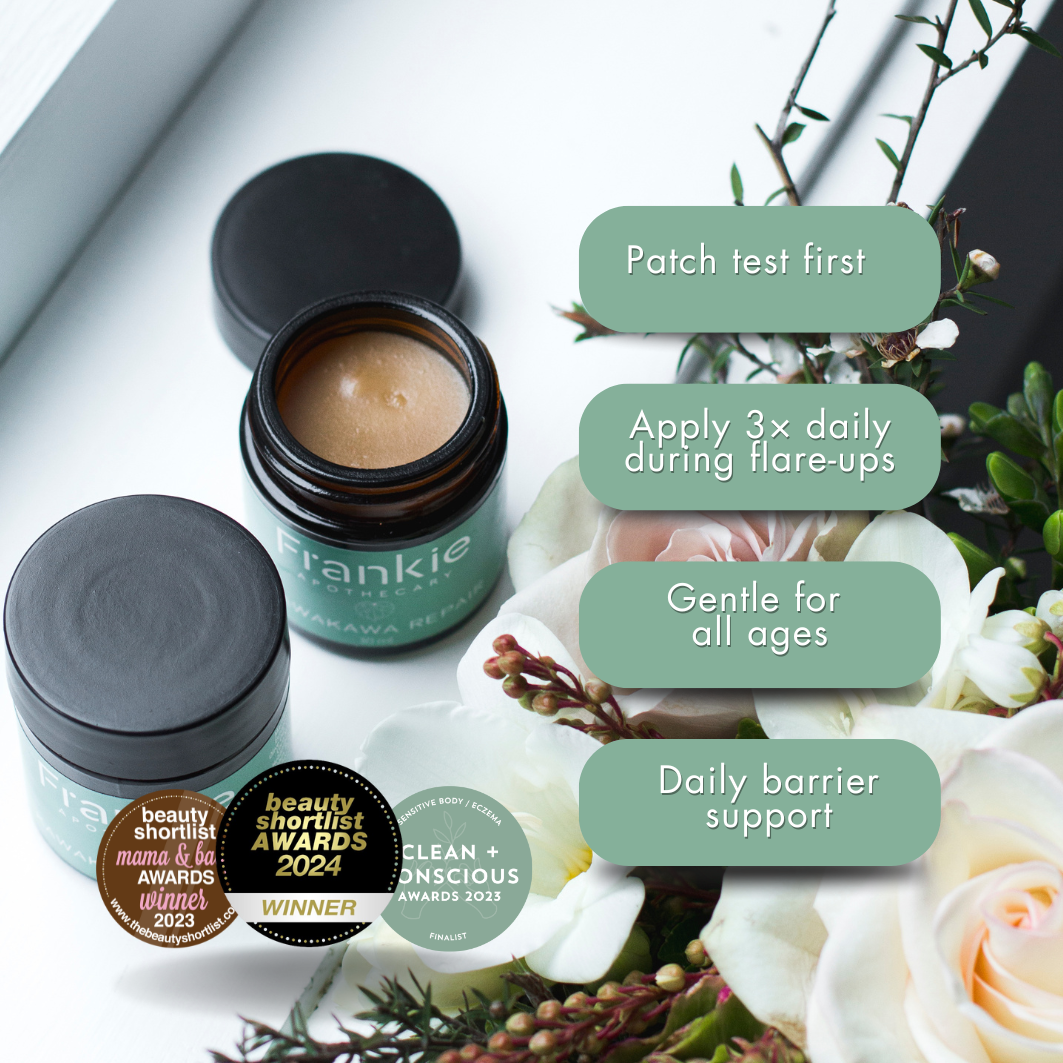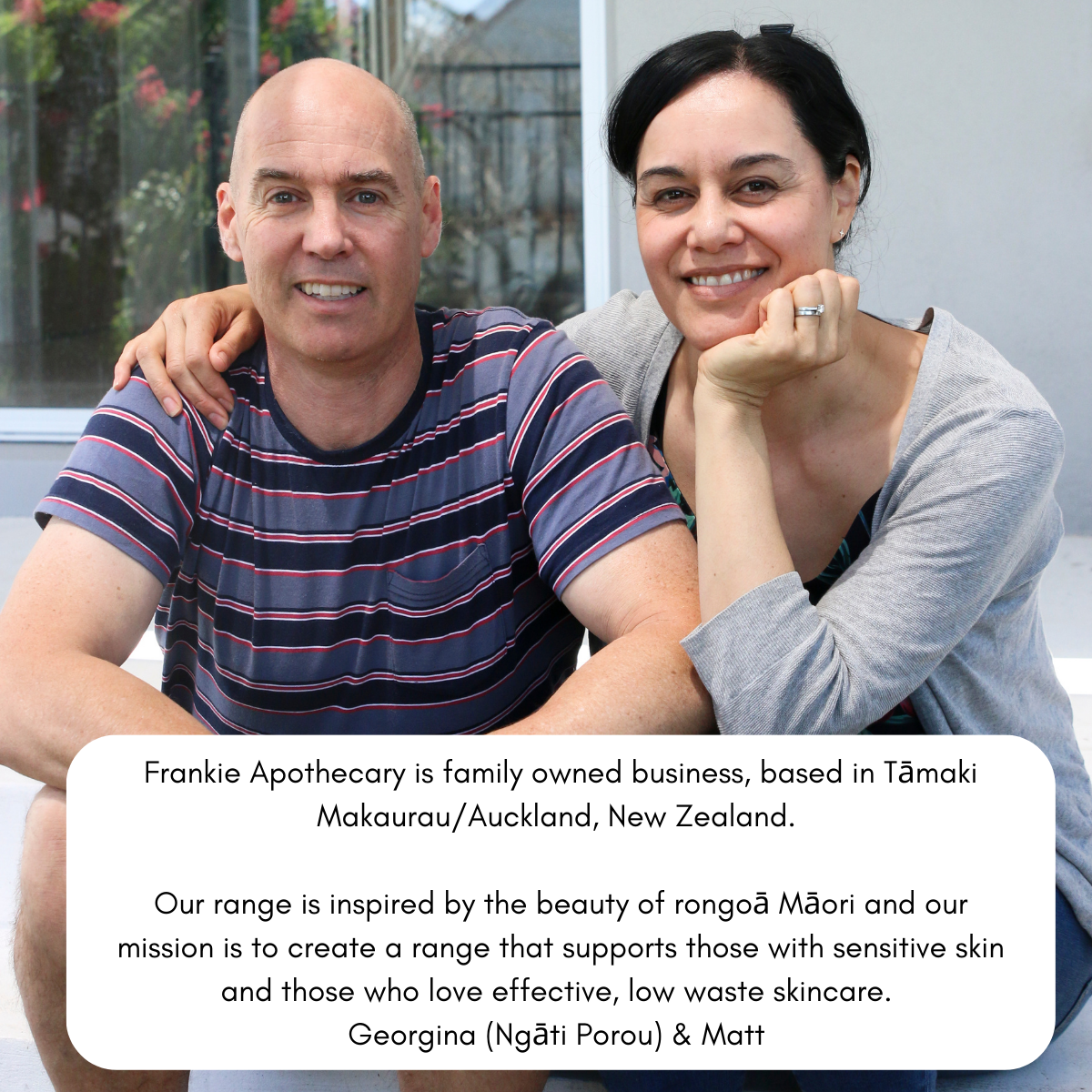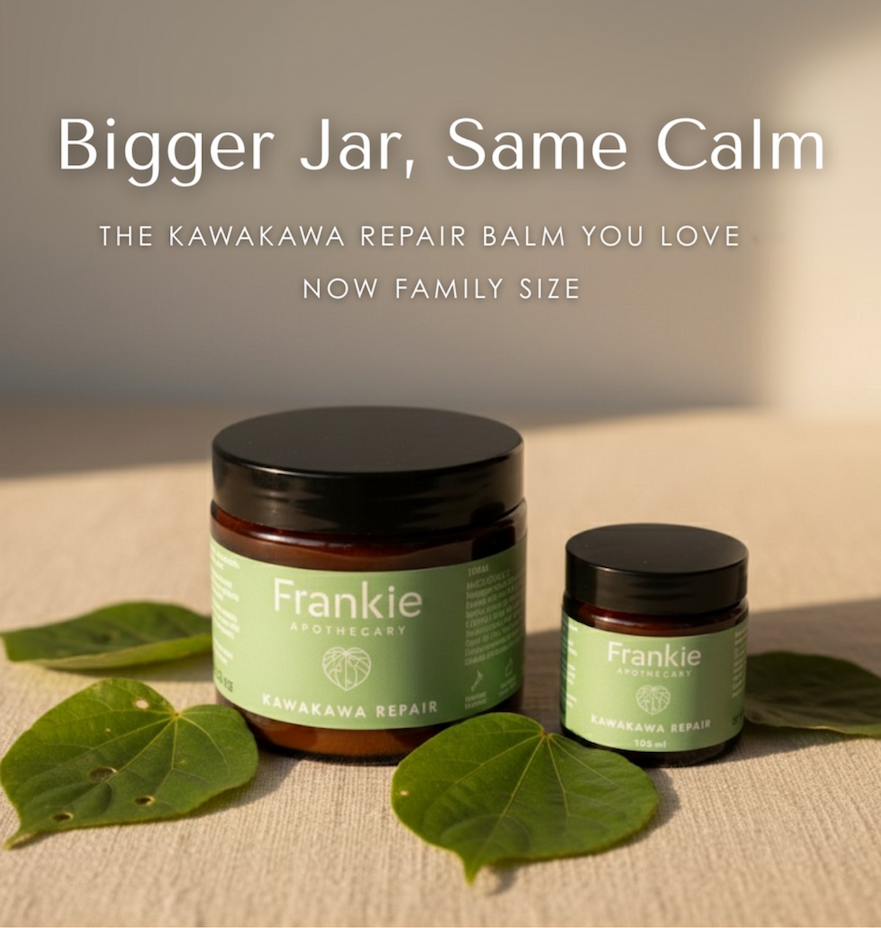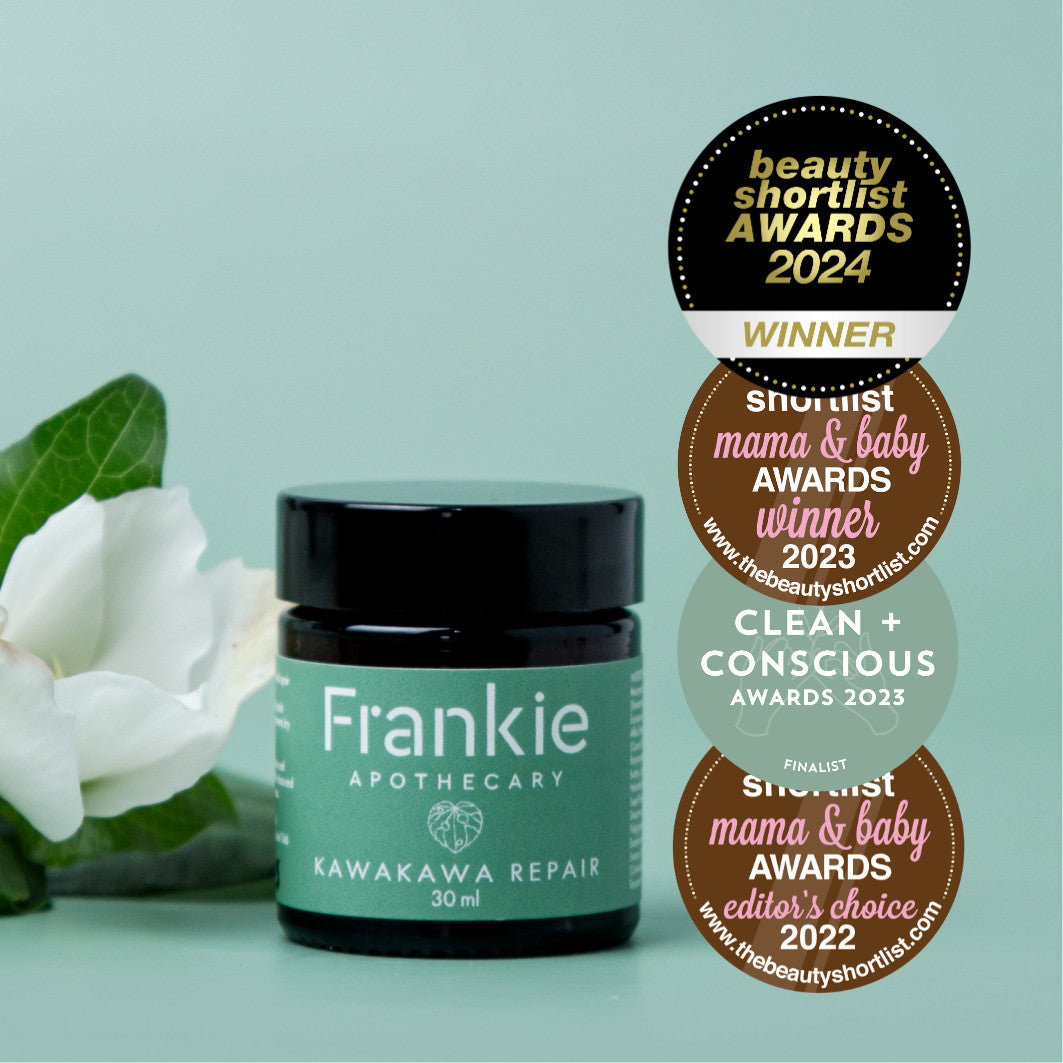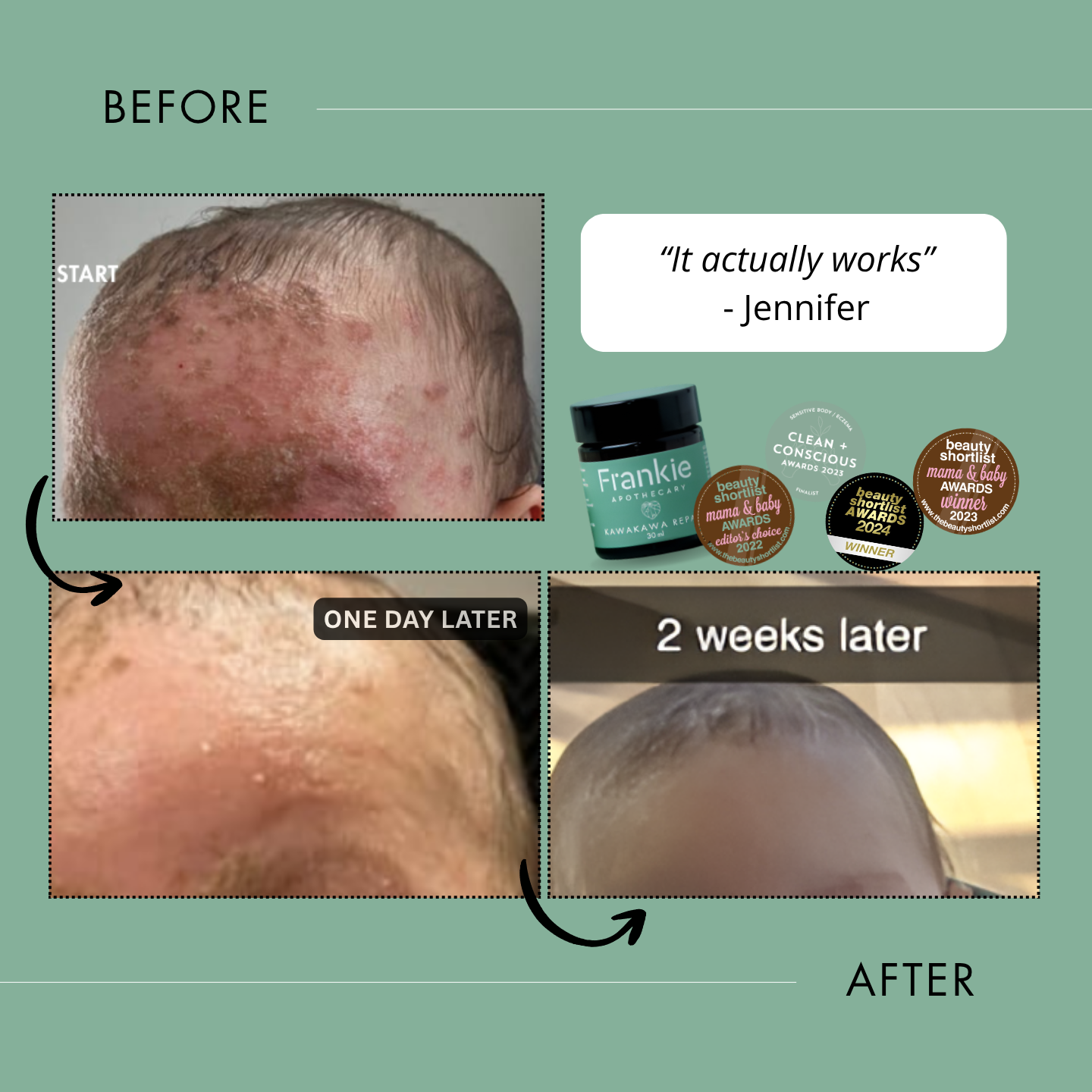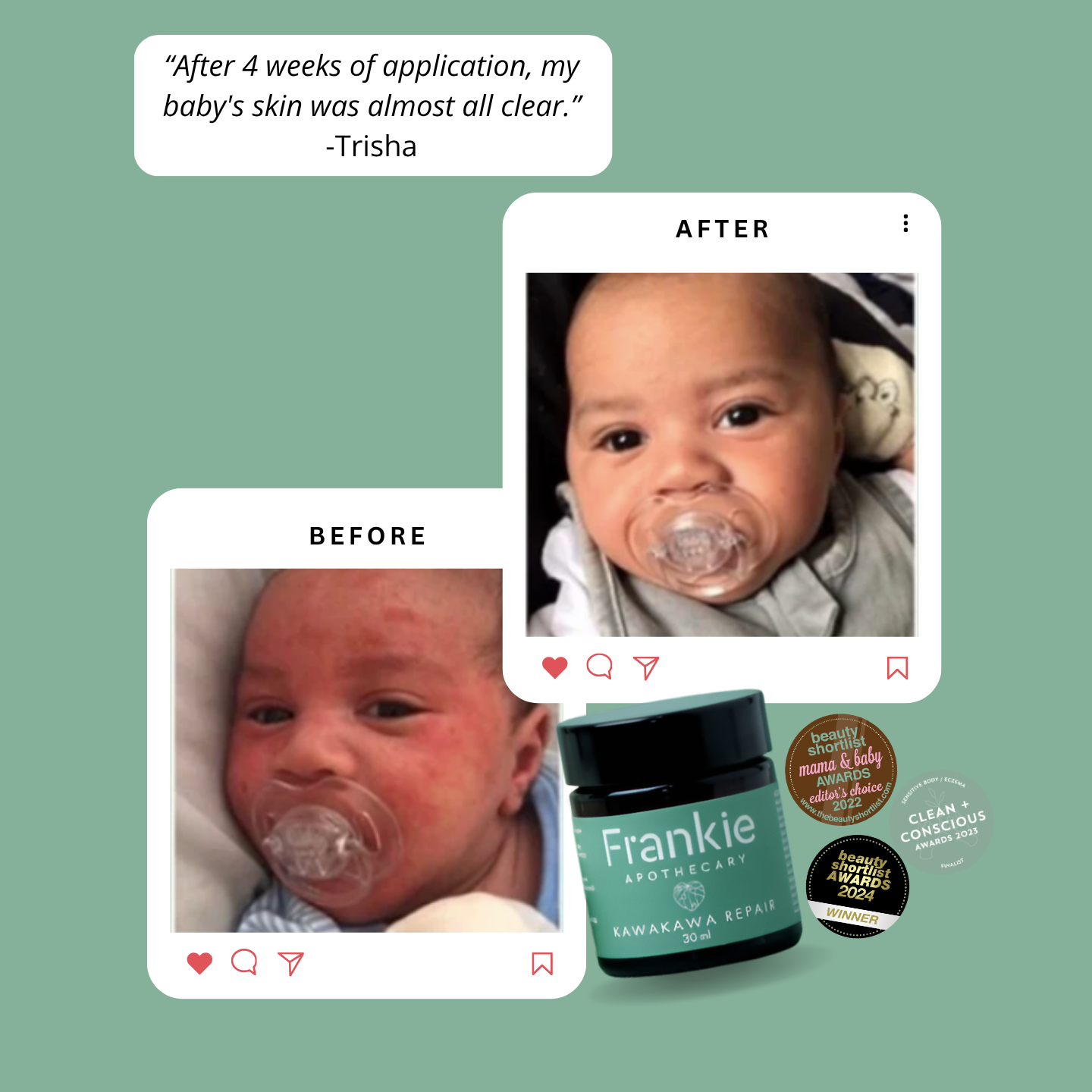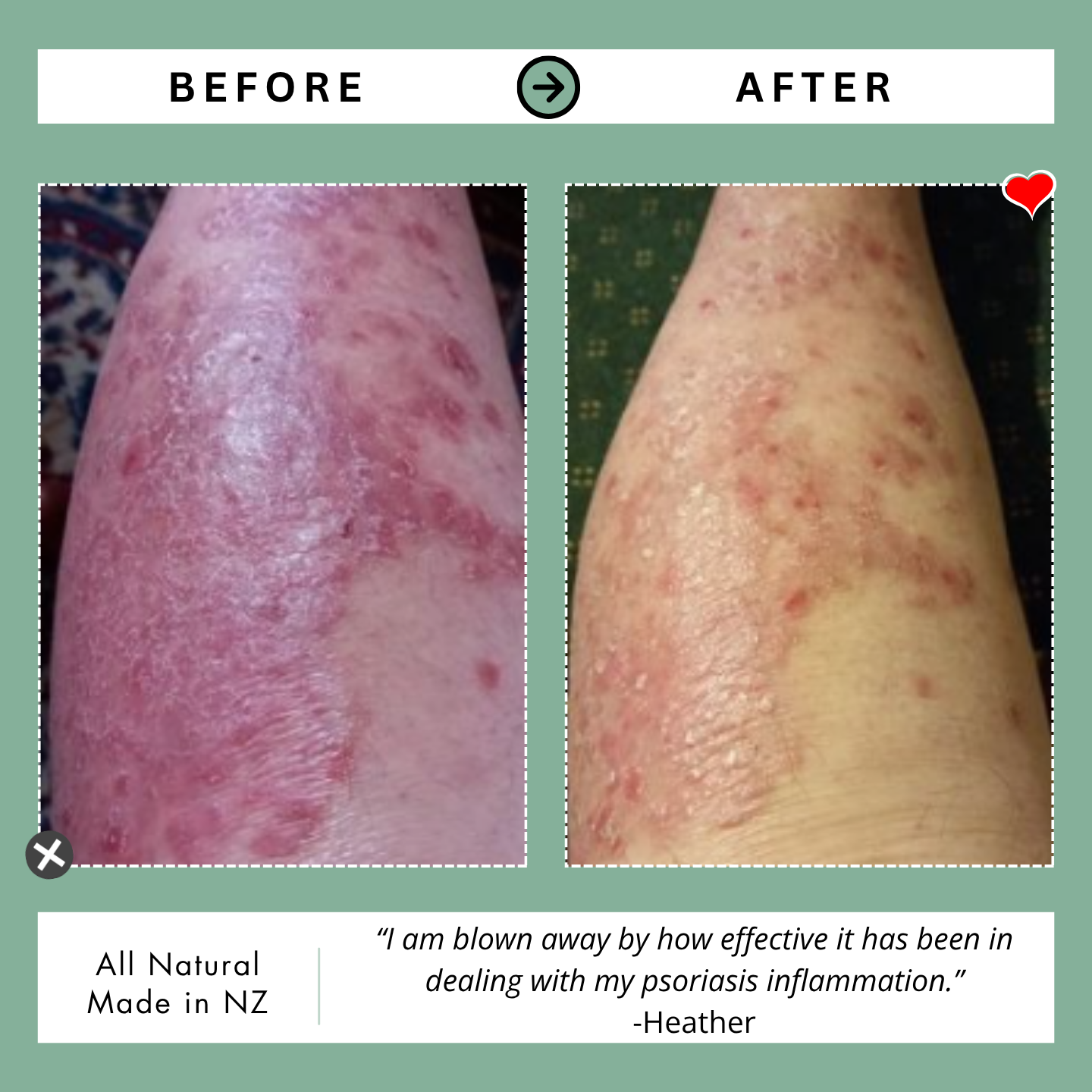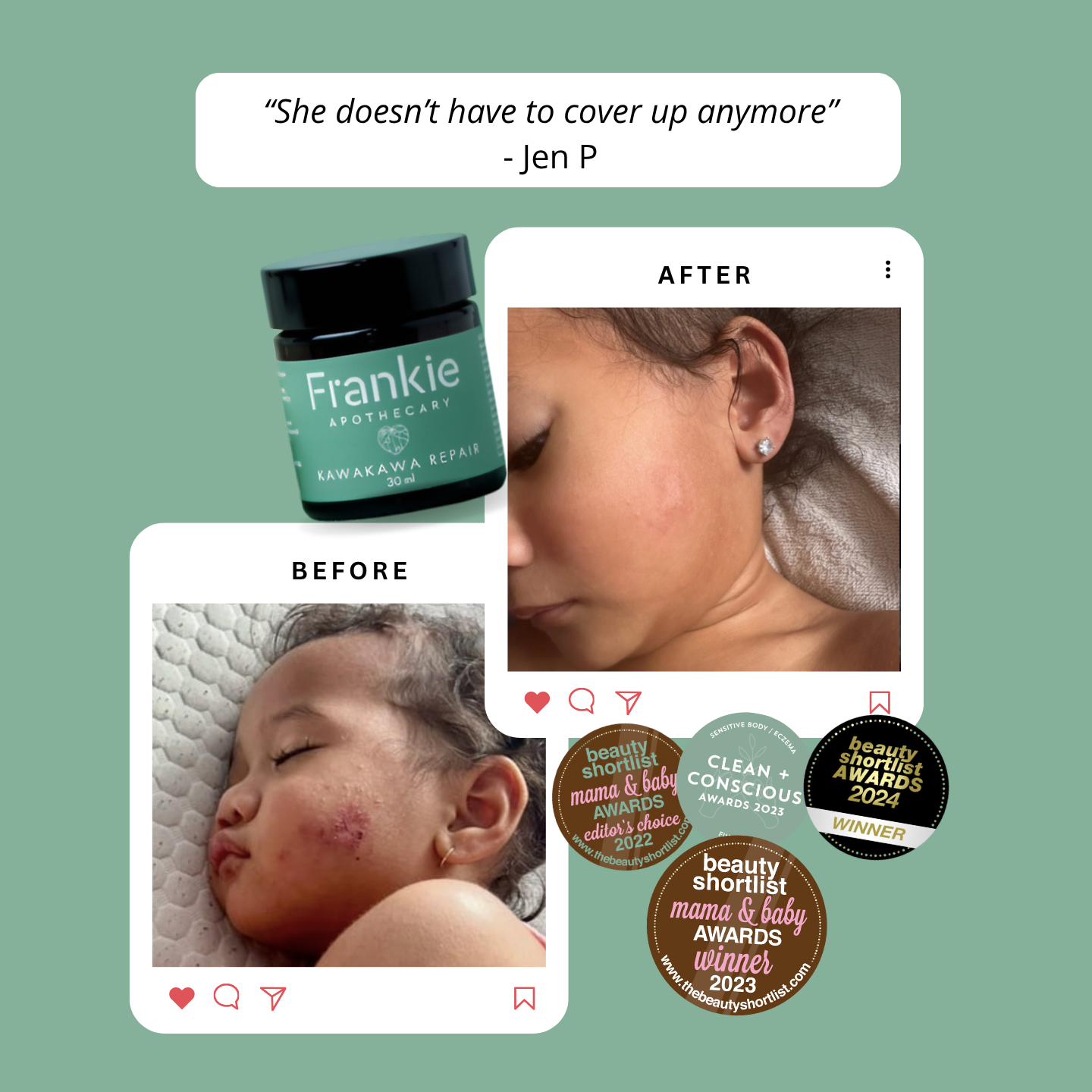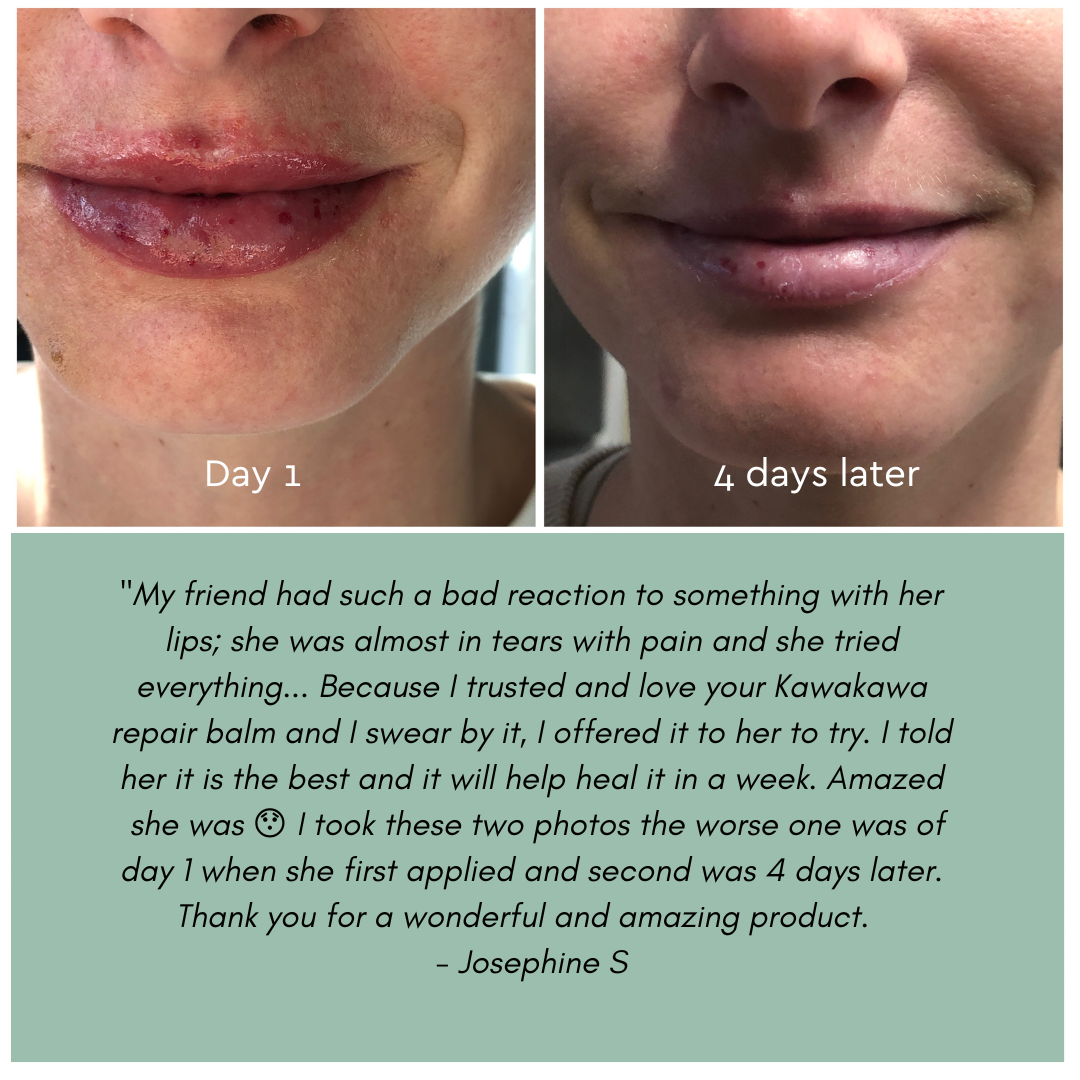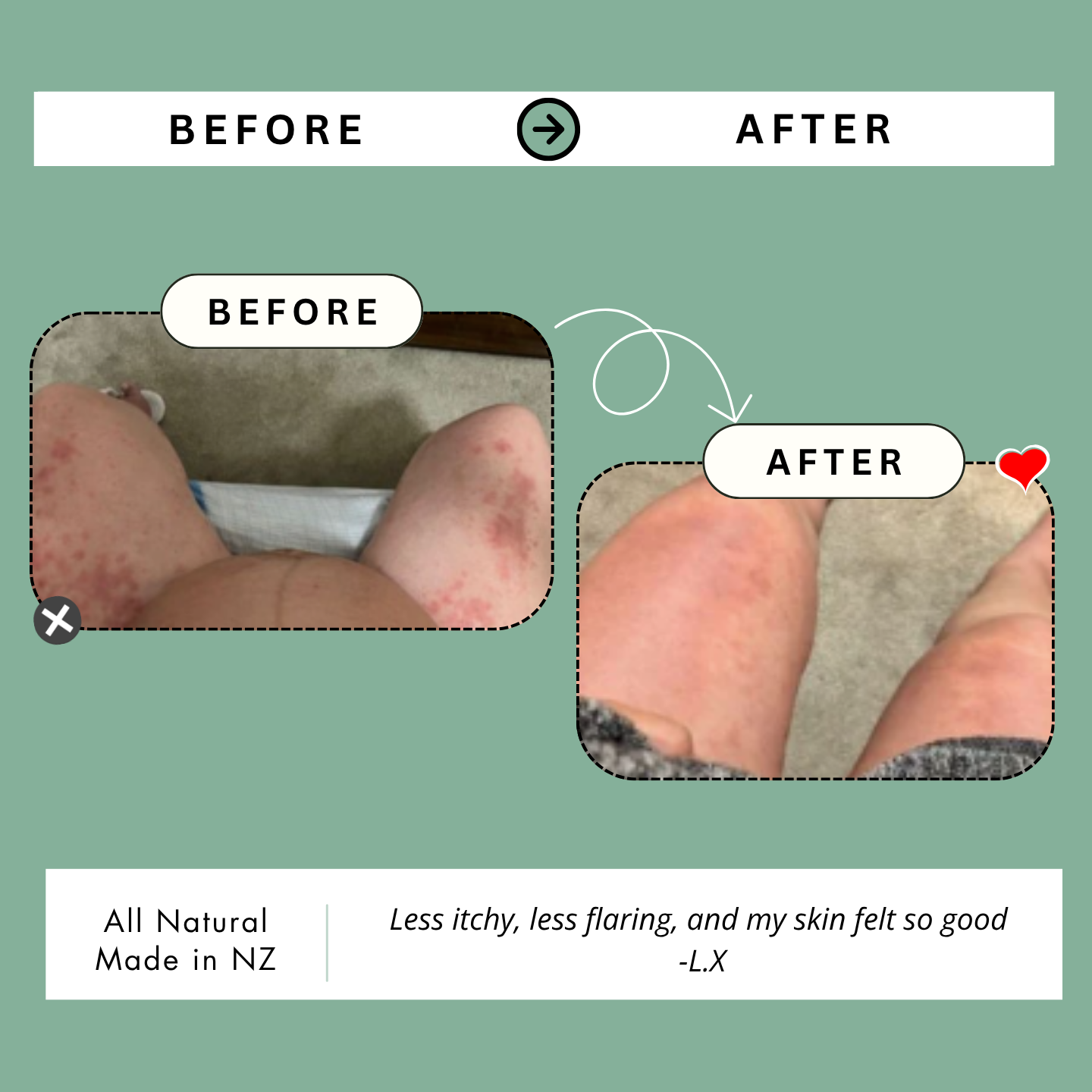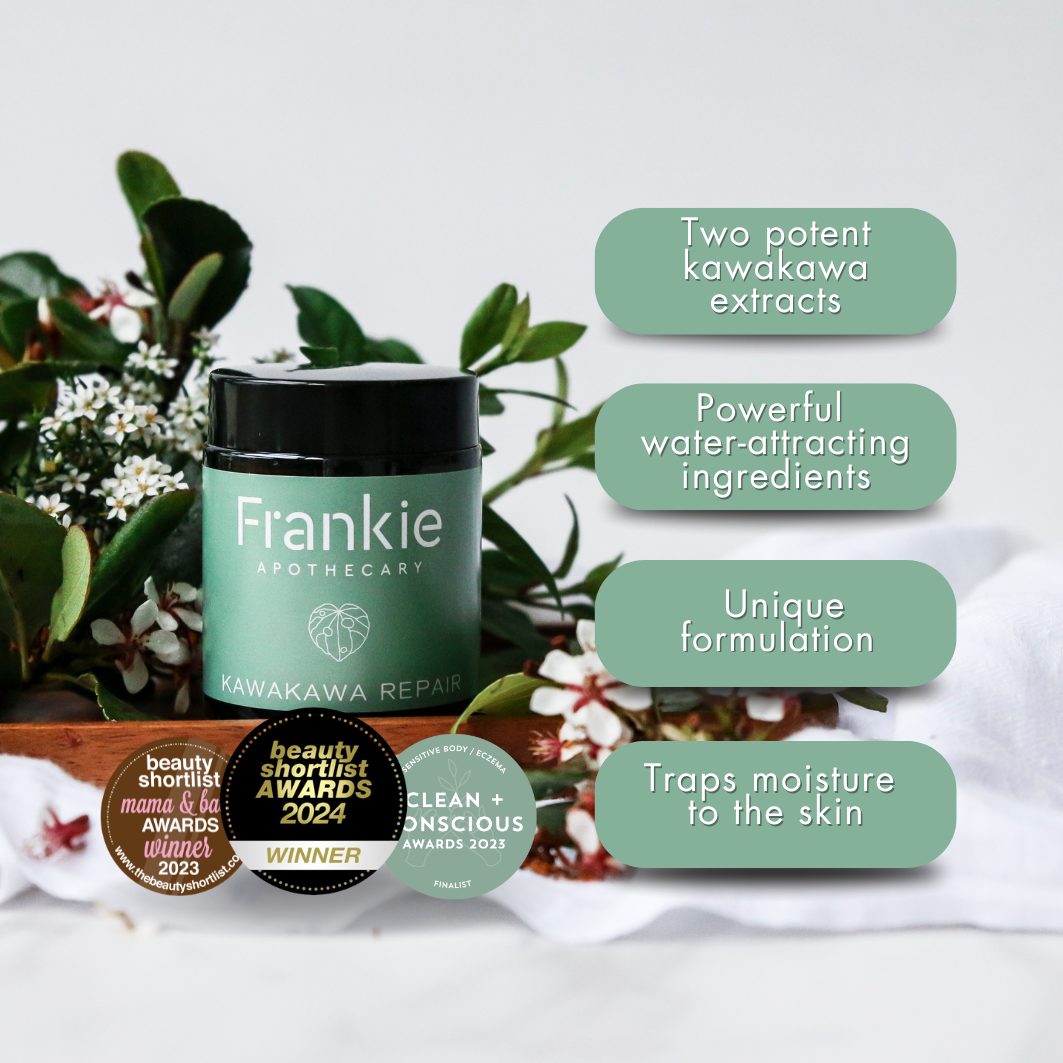Eczema often runs in families – frequently along with asthma and other hyper-reactive illnesses. These ties to family traits identify the genetic link that can play a part in the development of hypersensitive and reactive skin. In this article we round up various eczema triggers, and share ways to minimise the impact these triggers may have on your whanau's eczema. We've researched to find what chemical, environmental and physical triggers to avoid to reduce those awful eczema flare ups, and help support healthy skin.
Environmental triggers of eczema
Your environment plays a large part in eczema sensitivity, and can be what sets off a dormant family trait. If you have eczema, a tendency towards sensitive skin, or family members who suffer from skin irritations, you may want to reduce the environmental factors that contribute, in an attempt to reduce flare-ups.
Common environmental triggers of eczema flares include a dry climate, overheating, exposure to physical irritants (such as sand, dirt, or rough fabrics - read on for more on clothing!), a child scratching themselves, allergens such as dust mites, and bacterial skin infections.
Keeping your home well ventilated and warm but not overly dry is a great step. Vacuuming regularly, washing curtains, and ditching any old fluffy rugs to reduce dust mites in the home can make a big difference.
Natural cleaning choices can really help reduce eczema
Home is where we spend so much of our time and is often one of the most toxic largely due to big brand cleaners. Subtle changes to the chemical burden in our homes can significantly reduce our overall exposure. This is even more true for children who use the home environment differently to adults; they are often on the floor or closer to the ground where dust and toxins settle and so often have everything in sight in their mouth. Add this to a babe with a tendency towards eczema and the whole problem is compounded!
An easy starting place is in the laundry. For a relatively minor change in routine you can reap massive rewards. Just think, the clothes we wear, the towels we dry ourselves with, the sheets we sleep in, are all washed in laundry powder that is potentially chemically laden. Our skin has close to 24/7 contact with the chemical residues of laundering. So choose your products carefully. When you or your little one is suffering from red, itchy and broken skin it is vitally important that what you launder with is not aggravating the situation.
- What ingredients are necessary for the cleaning of clothes;
- What ingredients are triggering eczema;
- What ingredients are there to make the product store, smell and feel nice (i.e. the unnecessary chemicals).
Our advice - transparency is gold! A company with nothing to hide will have ingredients listed clearly. There are so many “nasties” in regular laundry products it can become overwhelming. This is a really great starting place to see how many of them are skin irritants or harmful to our bodies. You will absolutely want to avoid the products from this list. But in addition, be suspicious of anything labelled “fragrance”. This could be up to several hundred chemicals, including hazardous chemicals to get just the right synthetic scent.
An alternative is naturally scented laundry powders. For example Figgy & Co’s lemon laundry powder is scented with essential oil - from actual lemons! Not only is the scent natural - it is one ingredient - that also has degreasing properties; perfect for laundry!
Optical Brighteners are marketed as ‘wonder cleaners’ but this couldn’t be further from the truth. By design optical brighteners remain in the fibres of clothing and emit a blue light that we interpret as white and therefore clean. These chemicals embedded in our clothing are skin irritants and this reeks havoc on broken and sensitive skin. Instead use a natural based soaker to rid stubborn stains. Sure it will take longer (i.e. the soak time) but no chemical residues will be hiding in your clothes, and your clothes will actually be clean as opposed to looking clean.
Fabric softeners are designed to remain in your clothing to feel soft to touch.Once again all this equates to is chemicals contacting and aggravating your skin. instead, use naturally brewed white vinegar as a fabric softener - your towels will still be fluffy we promise!Line dry your sheets! When in the dryer, the chemicals emit volatile organic compounds (VOCs), some that are even considered hazardous air pollutants.
Drying clothes in the living space should be avoided. As clothes dry, the moisture is released into your environment. Damp homes are prone to the growth of mould, and the spores they release are known triggers for many suffering from eczema and other hypersensitive illnesses.
Dust and dust mites are a well-known trigger for people with hypersensitive reactions. Rolling and crawling around on the floor, playing under beds and behind sofas, and spending more time sleeping in bed on mattresses – all make babies and children more vulnerable. Vacuum often enough to keep the carpets and floors free from dust – when you do your vacuum you shouldn’t be getting bagfulls of dust! When it is time to dust your home, it is worth using a wet dust method – simply wipe down surfaces with a damp cloth trapping the dust onto you cloth and then rinse out in the basin. Be mindful of dusting not only the easily accessible areas – you’ll also want to maintain under beds, sofas and sofa cushions etc.
Fresh air is underrated! All materials let off gas, releasing tiny but active particles into the air. Often you can smell this process, fresh paints, glues and carpets. Open windows and let new air into your living space when you can.
Although eczema is recognised by the symptoms of the skin, inhaling ingesting and absorbing chemicals all play a part in the regulation of an eczema flare up. Choose cleaners for your whole house that are pared back in their formulations with ingredients that are known to be safe – there is no place for unnecessary or untested chemicals. As a rule mineral and plant based cleaners have a safer profile, and are less likely to add to the burden of a hyper-reactive state.

Rest assured that you can clean your home effectively with natural and non-toxic cleaners, as many generations before have done. Check out Figgy & Co - they have cleaning products and recipes for every room that are ONLY made from natural and nontoxic ingredients, and all with a known safety profile. Their recipes are published online so you can see exactly what is in them (or more importantly what is not) and you can even choose to DIY the cleaners yourself.
Action plan for home cleaning in an Eczema family:
- Leave shoes at the door as not to walk allergens and toxic particulate into your home;
- Open doors and windows often to exchange stale air with fresh air. Couple this with kitchen and bathroom fans to help draw out the old air;
- Vacuum often enough to keep dust levels down. Include mattress & under beds, behind sofas & under sofa cushions in your regular cleaning;
- Put a clean matt or blanket on the floor for non-crawling children to play on;
- Be realistic about whether your eczema home is better off without shedding pets;
- Wipe surfaces with a damp cloth to effectively collect settled dust;
- Choose home cleaners carefully – read the labels, if a company won’t disclose the chemicals they include in their formulations it’s impossible to make an informed choice;
- Consider making your own cleaners, this way you are in charge of what is in your home cleaners and allows for paired back formulations;
- Many basic homemade cleaners will do double duty, choose a handful of recipes and use them all over your home;
- Be very mindful of strong smelling and perfumed cleaners;
- Harsh and caustic cleaners have an irritating effect on even the most robust skin, its best to keep these formulations out of your home completely;
- In the laundry, use simple formulations that are clean rinsing to avoid chemical build up on clothes and linen;
- Avoid additives such as enzymes, optical brighteners and synthetic fragrance – all these things can add to the burden of reactive skin.
Eczema trigger - Clothing
Do you constantly hear your children complain that their clothes are making them itchy? Many parents have discovered the hard way that their children's clothing was exacerbating eczema flare ups. Many children with eczema cannot stand wearing wool or polar fleece as it causes their skin to itch.
Merino and other wool is often too abrasive, while polar fleece and other synthetics can make kids sweat more, allowing the damp to play havoc with eczema or rash-prone skin. Ribbed fabrics may act like sandpaper against your baby's skin, or you may notice that the seams in your children's clothes rub and cause abrasion of that sensitive skin. Under a microscope many clothing fibres have ridges and spars, which means they and can be extremely abrasive and cause more friction against already sensitive and inflamed skin.
Elastane can be another trigger for children with sensitive skin and eczema, and some children are actually allergic to elastane. If your child has a rubber allergy or sensitivity then they also need to be wearing elastane free garments.
Tips for eczema safe clothing:
- Choose soft natural fibres like organic cotton and bamboo. Under a microscope, bamboo viscose has a very smooth surface, and so does cotton (although it has a spiral-like twist)
- Look for flat seams inside clothes, or even external seams
- Avoid wool, polar fleece, ribbed fabric, elastane, anything with rough edges
- Be strategic with what you wash your family's clothing and sheets and towels in (read the section above). The residue left on garments from chemical washing powders, liquids and fabric softeners can be a major trigger for children with eczema and sensitive skin. Changing what you wash your whole family’s clothes and linen in keeps the chemicals out of your washing machine and off your clothes and bedding.
Food allergies and eczema
The latest research suggests it is rare that a food allergy triggers an eczema flare up, but there is evidence that eczema may cause a food allergy! 30% of babies with eczema and a family history of allergy develop a food allergy, compared to only 10% in the general population. There is some evidence that managing eczema well during infancy may reduce the chance of a baby developing food allergy.
Healthy skin in a young baby or child's forms an effective moisture barrier, and barrier against infections and allergens. If the baby's skin barrier becomes dry and leaky during early childhood, the angry inflammation of eczema summons immune cells to the skin and these can begin to 'recognise' food allergens within the skin from the baby’s home environment. We know that the longer the eczema lasts in these early stages of the immune system's development, and the more aggravated the eczema, the higher the chance the child will develop food sensitisation and food allergy.
When a child has eczema and a food allergy, their food allergy may trigger eczema, but the food is not the cause of their eczema. Most food allergies cause symptoms (including hives, vomiting and irritability) within 30 minutes of eating the food. Only occasionally does a food allergy result in delayed eczema flare ups.
Note that results of skin tests or blood tests for food allergy do not predict which food/s may be making the eczema worse, and a specialist doctor or nurse with training in allergy should be asked to interpret any food allergy tests that your child has.
Only try a 'food exclusion diet' if your child's eczema does not improve with treatment, and always do this under medical supervision.
The information on eczema and food allergies below was written by an incredible wahine, Kate Callaghan, nutrition expert and blogger who fought bravely against cancer, vulnerably and powerfully sharing her journey. Devastatingly, Kate lost her battle. We honour her for the passion and expertise she shared with Frankie many years ago.
NB: Please also research gut healing to support your child from the inside through a strong gut microbiome.
The role of food in eczema is a tricky one, but a well-established one, with many people seeing resolution in their eczema woes simply by making dietary adjustments. But how do you know if food is causing a problem for YOU? And how do you figure out WHICH foods are triggering a reaction?
The gold standard for identifying food intolerances and allergies is an elimination diet. I advise people to eliminate potential food triggers for at least ONE MONTH to see if their skin improves. The most common food allergens that could trigger an eczema flare include:
1. Dairy
This includes ALL dairy - milk, yoghurt, cheese, whey and even butter. Some people can tolerate A2 cow’s milk, while others can only tolerate goat or sheep milk, and others still can not tolerate any at all. To figure out which group you belong to, it is best to start your journey of discovery by eliminating all of these foods.
2. Gluten
Wheat, rye, barley, oats, spelt and kamut are all examples of gluten-containing grains. Be sure to read the labels of any packaged foods, as gluten may be hiding in there, however it will be clearly stated if this is the case.
3. Eggs
It is mostly the egg white that people find problematic, but there are some who also react to the yolk, so again - best to take the whole egg out for a short period.
4. Nuts
Peanuts and tree nuts (think almonds, cashews, walnuts) can be highly allergenic, and inflammatory for eczema sufferers.
5. Soy
You’ll find soy in soy milks, cheeses and yoghurts, as well as tofu, tempeh, edamame, miso and natto. Like gluten, it also hides in many packaged and processed foods. So, again, read the labels just to be sure
6. Legumes
Beans, lentils, chickpeas - the musical fruit! While these are not often considered to be an “allergenic food”, they can cause digestive issues, which could have a cascade effect of aggravating eczema.
So what's left to eat? And how will I meet nutritional requirements?
Good question! It is always best to work under the guidance of a health professional when doing an elimination diet, in order to make sure you are meeting all of your nutritional requirements. But don’t dismay! There are still plenty of things you can eat (and it is only for 1 month - not forever):
- Veggies - loads and loads of veggies! Eat the rainbow to make sure you reap the benefits of a wide variety of antioxidants, vitamins, minerals, and phytochemicals. Be sure to include starchy veggies (sweet potato, potato, parsnip) too, as these will provide the bulk of your carbohydrate intake
- Fruit - again, vary it up, choosing different colours, and always choose the whole fruit (rather than dried or juiced) so you’re also getting the fibre. Be careful of citrus, though, as some people can find that it makes their eczema worse
- Meat, poultry (except eggs), seafood - eating good quality protein each day is a must. Wild caught salmon and sardines, as well as grass-fed meat, are very high in omega-3 fatty acids, which are anti-inflammatory and can be very nourishing for the skin.
- Organ meats, such as liver - Liver is a true superfood! Just 50g will provide over 50% of ALL of your daily vitamin and mineral requirements. It’s also especially high in vitamin A, which is essential for healthy skin. Be sure to choose organic, and don’t go overboard (as too much vitamin A can be toxic)
- Fats - when you have eczema, fat is going to be your best friend. It is truly nourishing for your whole body, especially your skin, helping with cellular integrity and moisture at the deepest level. Choose unrefined sources of fats, such as avocado, olive oil, coconut products, ghee and macadamia oil. Use them liberally and enjoy the health and taste benefits!
- Fermented foods - sauerkraut, coconut yoghurt, kombucha and beet kvass - these are all loaded with beneficial bacteria, which is going to boost your gut health and have a flow-on effect of healing your skin.
- Gluten-free grains - quinoa, buckwheat, amaranth and rice can all be healthy substitutes for someone on an elimination diet, though I will say that, in most cases, I do advise also eliminating these as they can potentially cause digestive issues which can contribute to an eczema flare.
So a simple meal might look like this:
- Palm size of animal protein
- Fist size of starchy veggies
- 2-3 fist sizes of non-starchy veggies
- Liberal serve of fat (why not bake the starchy veggies in coconut oil, and drizzle olive oil over the non-starchy veggies?)
- 1 tablespoon of fermented foods
And a snack might look like this:
- Piece of fruit with some coconut butter
- OR a fruit smoothie made on coconut milk or water
- OR ½ an avocado sprinkled with chives and a small drizzle of balsamic vinegar (delicious!)
How to tell if a food is actually triggering an eczema flare
OK, so you have eliminated all of the above potential food triggers for one month, and you’re excited to start adding them back in. HOLD ON - DO NOT RUSH THIS!
You will need to reintroduce just ONE food at a time, and I suggest only focusing on one food each week, as it can take up to 4 days to notice a reaction. So - choose the food you are going to introduce. Enjoy it. Then keep a detailed food journal over the next few days to see if you notice any adverse reactions.
If you notice your eczema flares with any food introduction, remove that food immediately, make a note that this food caused a reaction, and wait until the flare settles before moving on to your next food reintroduction. You can try reintroducing this food again at a later date. If it causes a reaction AGAIN, then it is likely that this food is not your friend, and it’s best to steer clear as much as possible.
If you do not notice a reaction, then HURRAH! You can likely keep this food in your diet!
This method of discovering food triggers can be a bit laborious. It does take time, focus and commitment, but it is well worth it in the long run. Hope this helps! As a fellow long-time eczema sufferer myself, I can truly vouch for the healing (and harming) potential of foods.
Good luck!
Kate



